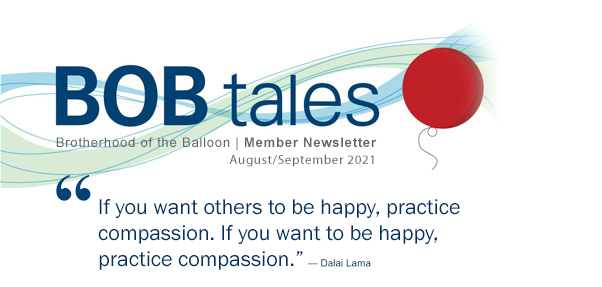
Dear Members (a note from Deb Hickey):
National Prostate Cancer Awareness Month is observed every September in the U.S. by health experts and advocates, and others concerned with men’s prostate health. The purpose is to increase awareness of the importance of prostate health and screenings, educating about risk factors and symptoms, and advocating for research.
For me, September is a reminder of what I’m truly grateful for – proton therapy and Loma Linda University Cancer Center. My father, Bob Marckini, is not only here with me – he’s healthy, happy, and spends his days helping others learn to advocate for their own health and learn about the many available prostate cancer treatment options, most notably, proton therapy.
But my father’s dedication to helping others begins with his family. And I’m reminded of that every single day.
My sister just moved into an apartment. It’s the first time she’s ever lived alone (That’s a long story). So, my dad, concerned for my sister’s well-being, got to work. He first called the cable company to have her TV and Internet installed. “Background TV programming helps people feel less isolated … I don’t want her to feel lonely for a second.” He then visited the apartment complex to assess the grounds, the building, and meet the landlord. He subsequently examined each window in the unit to ensure one or two were the proper size to fit a portable air conditioner. He checked and double checked the door and window locks. He installed a mailbox on her door and glued a post-it sized address label to the front. He then measured every room, every hallway, and every closet.
Later that day, Dad created a comprehensive floor plan on graph paper, complete with little movable paper cut-outs for her dressers, bed, lamps, sofa, tables, and chairs so she could arrange and rearrange furniture placement (You can’t make this stuff up). He called the landlord to ensure the parking lot would be paved (it was a pile of rocks when we first saw the apartment) and accessible for the moving truck.
On move-in day, Dad spent about two hours sanding and re-painting my sister’s closet doors because they were sticking together. He helped her unpack and clean. He filled her kitchen cabinets and fridge with food. He removed all the trash and took it home with him.
Do all dads do this? I mean to this extent?
This is one small example of the way my father takes care of his family. The hoops and hurdles and obstacles and mountains my father climbs every day to ensure we’re happy, healthy, and safe are colossal. I think most fathers/father-figures feel a responsibility to protect and care for their families, but my dad goes above and beyond. His selflessness is immeasurable. He works harder than anyone I know – for us, for you, and for anyone he meets (he’s on the phone with newly diagnosed prostate cancer patients ALL the time). I’m just … grateful he’s here. And Prostate Cancer Awareness Month, for me, is a celebration of the treatment that saved my dad’s life and preserved the quality of his life.
No matter how hard we try to keep them short, our newsletters are always about 20 pages (except for last month – which was 34. I had to apologize to our editors) because after scouring the Internet, NAPT’s member resources, the COMPPARE newsletter, Prostapedia Digest, and other sites with important information about proton therapy and prostate health, we have to pick and choose and consolidate and edit all the information we think will be of value and interest to our readers. We also try to lighten things up a bit with Odds & Ends and some humor. I hope you always find the information relevant, useful, and maybe even entertaining!
This month, we report on a new approach to finding advanced prostate cancer, a blood test that can detect more than 50 types of cancer, and a new bill approved in Oregon to ease barriers to proton therapy for prostate cancer. We also discuss Vitamin D and its potential to reduce deaths from cancer; white mushrooms and their ability to slow down the progression of prostate cancer; a big announcement by the National Association for Proton Therapy regarding their next annual conference; and more.
We hope you enjoy this issue of the BOB Tales. As always, we welcome and encourage your feedback. Please send an email to [email protected].
Deb Hickey
To print the BOB Tales newsletter or view the newsletter with a larger font size, click here for the PDF file.
In This Issue:
- FDA Approves New Imaging Tool to Find Advanced Prostate Cancer
- Blood Test Finds 50 Types of Cancer
- BOB Member Successful in Passage of Oregon Proton Bill
- Even Doctors Need to do Their Homework
- Possible Benefit for Vitamin D
in Cancer Care - White Mushrooms May Slow Progression of Prostate Cancer



FDA Approves New Imaging Tool to Find Advanced Prostate Cancer
We’ve touched on this subject before when discussing advances in PET/CT body imaging. This subject is also related to the new Theranostics technology being pioneered at Loma Linda University Cancer Center.
This new approach is not intended to replace blood screening tests, but it should be a benefit in helping doctors deal with advanced, metastatic, and recurrent prostate cancer.
The technology involves a tracer, manufactured by medical imaging company Lantheus, which helps doctors find cancer that has moved to the bones. The tracer molecule seeks out prostate-specific membrane antigen (PSMA). It lights up on a PET scan after having been injected into the blood stream.
A similar tracing agent, which also seeks out PSMA, was approved by the FDA in December for use at two California hospitals: the University of California, Los Angeles, and the University of California, San Francisco.
“We’ve been using it for many years and it works great,” said Dr. Thomas Hope, director of molecular therapy in UCSF’s Department of Radiology and Biomedical Imaging. “We can actually see where the disease is and now people are getting targeted radiation.” Dr. Hope said that this technology is “redefining how we think about prostate cancer.”
This technology is perhaps most useful for men with rising PSA after having surgery or radiation for prostate cancer, indicating the cancer has returned and possibly spread to other parts of the body.
This imaging also helps doctors determine which kinds of prostate cancer cells are likely to be more dangerous. Some cancers – even some metastatic cancers – are not life-threatening, says Dr. Derek Raghavan, president of the Levine Cancer Institute in Charlotte, North Carolina, who is involved in this research.
When the exact location of the cancer is found, it can be treated with targeted therapies, such as radiation, and even with curative intent.
The entire landscape of cancer detection and treatment is changing. We are fortunate to be able to witness, and even access, some of these important advances.
Blood Test Finds 50 Types of Cancer
Last month, The Guardian reported on a significant development published in the journal Annals of Oncology, about a simple blood test that can detect more than 50 types of cancer. And the best news is that this test can find cancer before any clinical signs or symptoms of the disease show up. Detectable cancers include difficult-to-diagnose cancers such as head, neck, ovarian, pancreatic, esophageal, some blood cancers, and many more. Another important factor is that the false positive rate is very low with this test.
Grail Medical, headquartered in Menlo Park, CA, developed the test, which looks for chemical changes, called methylation patterns, in fragments of genetic code, called cell-free DNA, that leak from tumors into the bloodstream. Scientists report the test has an impressive level of accuracy.
This latest study followed more than 4,000 people – some with disease and some without. “It correctly identified when cancer was present in 51.5 percent of cases across all stages of the disease, and wrongly detected cancer in only 0.5 percent of cases,” according to The Guardian. “In solid tumors that do not have any screening options – such as esophageal, liver and pancreatic cancers – the ability to generate a positive test result was twice as high (65.6 percent) as that for solid tumors that do have screening options such as breast, bowel, cervical, and prostate cancers.” Positive test results were reported at 55.1 percent in blood cancers, such as lymphoma and myeloma. And, the success rate for detecting cancer in body tissue was 88.7 percent.
In many respects, this test is a game changer because, “finding cancer early, when treatment is more likely to be successful, is one of the most significant opportunities we have to reduce the burden of cancer,” says Dr. Eric Klein, chairman of the Glickman Urological and Kidney Institute at Cleveland Clinic.
The National Health Service in the UK is conducting a pilot test involving 140,000 patients. Results are expected in 2023. NHS clinical director, Prof. Peter Johnson, believes this new blood test could help find three-quarters of cancers at an early stage, when they have the highest chance of a cure.
This new form of “liquid biopsy” truly is a game-changer. We’ll provide updates as things develop.
BOB Member Successful in Passage of Oregon Proton Bill
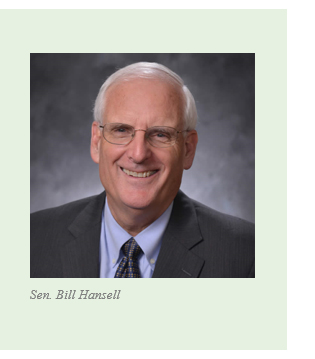 Bob Marckini first met County Commissioner Bill Hansell when they were both in treatment at Loma Linda in late 2000. Like so many patients treated at Loma Linda, they became good friends and have communicated regularly for the past 20 plus years.
Bob Marckini first met County Commissioner Bill Hansell when they were both in treatment at Loma Linda in late 2000. Like so many patients treated at Loma Linda, they became good friends and have communicated regularly for the past 20 plus years.
Bill served eight terms as Umatilla County Commissioner with many notable achievements as President of the National Association of Counties, President of the Association of Oregon Counties and numerous boards and committees. In 2015 Bill was elected state senator, District 29, Athena, OR.
In addition to a long list of community, civic, and church activities, which earned him Citizen of the Year and other honors, Bill has been intensely vocal over the years in his support of proton therapy access for all Oregonians.
Just recently he successfully promoted a bill to ease barriers to proton therapy for prostate cancer. Senate Bill 2A, approved last month by the Oregon Senate, removes some of the insurance barriers patients face when they choose proton therapy for prostate cancer. The bill prohibits insurers from imposing prior authorization requirements on proton therapy coverage that are more restrictive than requirements for conventional radiation therapy.
“I have personally benefited from this treatment, but it required jumping through too many insurance hoops,” said Sen. Hansell. “If an Oregonian and his doctor decide proton beam therapy is the best treatment option, this bill will make it easier to access.”
Previously, Sen. Hansell sponsored legislation, Senate Bill 740, which requires insurers to cover proton therapy in the same way they cover conventional radiation therapy. But that bill had a loophole that allowed insurers to put extensive prior authorization conditions in place. This new bill removes those restrictions.
The new bill, which has also passed the House, next goes to Gov. Kate Brown’s office for approval.
Great work, Sen. Hansell!

We’ve been producing BOB Tales newsletters monthly for more than 20 years. During this time there have been articles that many new members haven’t seen, and some older members may have forgotten. So, we periodically re-run articles from past newsletters. The following is from August 2008.
Even Doctors Need to do Their Homework
One of our members sent us a copy of the July 4, 2008, New York Times article, “Prostate Cancer Decisions Often Based on Fallacies.” Certainly, the title of the article is true, but the study referred to in the article was shallow, and the reporting was superficial in our opinion.
Bottom line: Many men seem to choose their treatment option based on either a) what their urologist encourages them to do (which is usually surgery), or b) the experience or recommendation of a relative or a friend. Many, we’ve learned, who chose surgery, did so because they had the mistaken belief that having their prostate removed is the only way they could be sure of a cure. If this were true, then how come there are so many men being treated with protons or conventional radiation following surgery?
One of our members told us recently that his primary care physician, who is also a friend, was recently diagnosed with prostate cancer. He tried to persuade his doctor/friend to consider proton treatment, but the doc opted for the “gold standard.” And now, a few weeks after surgery, this physician has not returned to work; he’s probably impotent and incontinent; he’s learned that there was cancer in the margins and is scheduled to undergo a complete regimen of external beam radiotherapy. So sad.
Not all surgeries turn out this way – most are successful – and all urologists don’t necessarily steer their patients into radical prostatectomies. But the message we should get from all this is that patients – even patients who are physicians – must do their homework when making treatment decisions, especially for prostate cancer treatment. Bob’s urologist knew nothing about proton therapy, which means if he were ever diagnosed, he probably wouldn’t consider proton. Unfortunately, it would be his loss.

Reasons to Give ─ Successful Treatment, Healthier Lifestyle
Bill McClasky felt pretty lucky when he was just shy of turning 64. He’d completed eight years as a development economist in Africa and 23 years as a financial services industry executive. He was in the midst of his third career as an arbitrator for cases brought before the Financial Industry Regulatory Authority and as an expert witness in securities cases when his sense of well being abruptly ended.
Rising PSA prompted Bill’s primary care doctor to order a prostate biopsy in December 2002. And as “luck” would have it, he was diagnosed with prostate cancer. “After the shock wore off, I called my friend, Russ, who’d recently undergone some type of treatment and was raving about it,” said Bill. He later learned that Russ had conducted a careful study of all the prostate cancer treatment options, including visits to radiation oncologists and surgeons. He’d selected proton beam radiation therapy at Loma Linda University Cancer Center in California and had only positive things to report about his experience. “I was intrigued and hopeful,” said Bill. “And then Russ referred me to a man he described as ‘the most valuable resource for information on prostate cancer’ – Bob Marckini.”
“Bob talked me off the ledge,” said Bill. Through a series of telephone conversations, Bob “patiently walked” Bill through the advantages and disadvantages of the many available prostate cancer treatment options and then thoroughy explained his experience of proton therapy at LLUCC two years prior.
Bill decided to undergo proton therapy just before the new year, however shortly thereafter, he slipped on black ice and broke his left tibia and fibula. “I needed a complete reduction involving two seven-inch titanim plates and 14 screws,” Bill said. So, when he arrived in Loma Linda a few weeks later, he was in a wheelchair with a toe- to mid-thigh cast.
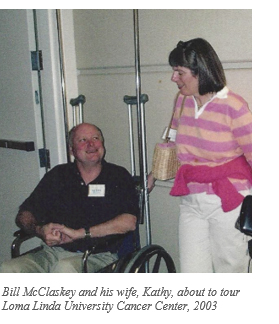 Fortunately, the staff at Loma Linda carefully attended to Bill and his daily treatments were followed by physical therapy at a nearby rehabilitation center. And although hiking and tennis were off the table, Bill and his wife, Kathy, were determined take every possible advantage of beautiful, southern California. “We visited the wheelchair-friendly Getty, L.A. County, Riverside, and Palm Springs Desert museums. We saw the blooming poppies in Lancaster, Santa Monica Pier, and Muscle Beach. We enjoyed Sunday brunch at the Riverside Inn and sidewalk cafes in Palm Springs. And at least Kathy was able to run on the track and swim at Loma Linda’s Drayson Fitness Center.”
Fortunately, the staff at Loma Linda carefully attended to Bill and his daily treatments were followed by physical therapy at a nearby rehabilitation center. And although hiking and tennis were off the table, Bill and his wife, Kathy, were determined take every possible advantage of beautiful, southern California. “We visited the wheelchair-friendly Getty, L.A. County, Riverside, and Palm Springs Desert museums. We saw the blooming poppies in Lancaster, Santa Monica Pier, and Muscle Beach. We enjoyed Sunday brunch at the Riverside Inn and sidewalk cafes in Palm Springs. And at least Kathy was able to run on the track and swim at Loma Linda’s Drayson Fitness Center.”
Overall, Bill had an “extraordinary” experience of treatment at LLUCC. His “lasting memories” include:
The exceptional kindness and professionalism of every single person we met at Loma Linda. The doctors, treatment techs, administrative staff … even the workers in the delicious vegetarian cafeteria were kind and attentive!
The friends we made – mostly fellow patients – those I sat with while awaiting treatment.
The informative, yet very social, Wednesday night meetings. What a sense of community there is at Loma Linda!
Acrobatics … mastering the vault from a step-ladder into my own customized pod while wearing a heavy cast.
The smell of orange blossoms through the open windows of our rental appartment near the hospital.
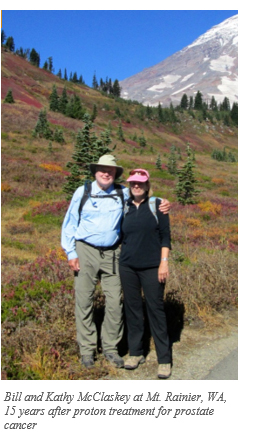 Bill also adopted a healthier lifestyle when he returned home. “Loma Linda instilled that in me,” he said. And after his leg healed, Bill began more strenuous physical activies, including hiking with Kathy in alpine and wilderness areas.
Bill also adopted a healthier lifestyle when he returned home. “Loma Linda instilled that in me,” he said. And after his leg healed, Bill began more strenuous physical activies, including hiking with Kathy in alpine and wilderness areas.
For the past 12 years, Bill has been a member of a group of retirees who walk together for four to six miles, five days a week, near his home in Hingham, MA. “There’s former computer salesman, an obstetrician, a mutual fund portfolio manager, and a civil engineer.” Bill said. “We engage with the folks we encounter on our walks, dispensing good cheer, unsolicited advice and opinions, and questionable wisdom.”
Bill is also an annual contributor to proton research at Loma Linda via the Robert J. Marckini Endowed Chair. “My yearly gift is my way of giving thanks and support to the technology and philosophy that have most profoundly improved my health and lifestyle choices.”
Still Available!
In an effort to boost funding for basic and clinical proton therapy research on prostate cancer, pancreatic cancer, liver cancer, breast cancer, and more, we asked our members to donate $100 (or more) to Loma Linda University Cancer Center. In return, they’d receive an advance copy of Dr. William Preston’s book, Don’t Just Stand There – Realizing a Vision for Proton Therapy: Conversations with James M. Slater, MD, FACR. The response so far has been phenomenal. Thank you to all who’ve requested a copy.
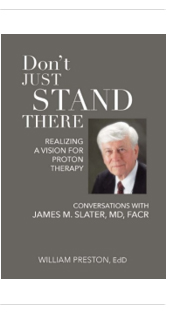 If you’d like a pre-published copy of “Don’t Just Stand There,” please send a check for $100 or more, payable to “Loma Linda University Proton Cancer Research” and mail it to:
If you’d like a pre-published copy of “Don’t Just Stand There,” please send a check for $100 or more, payable to “Loma Linda University Proton Cancer Research” and mail it to:
Loma Linda University Health ● Office of Philanthropy ● PO Box 2000 ● Loma Linda, CA 92354
Please notify Deb Hickey at [email protected] that you’ve sent in your check and your book will be mailed immediately.
This book, which contains high-quality color images and illustrations, is not only about Dr. Slater’s quest to create the world’s first hospital-based proton treatment center, it’s also a teaching guide. As the Proton Treatment & Research Center at Loma Linda was such an immense endeavor, Dr. Slater wondered if the aspects of conceiving, planning, and orchestrating such a project, among others he undertook, might be instructive to others. Over the years, he’d also met people in all walks of life, many of whom had dealt with large and complex problems. He was struck by some of the stories they told about their work. And although the fields or disciplines usually had nothing to do with medicine, many experiences were similar. And so, he kept this in mind while he worked on the book with Dr. Preston.
We’re sure you’ll thoroughly enjoy the book and we know it will occupy a place of honor
in your home. And, you’ll be helping to fund basic and clinical proton research on prostate cancer, pancreatic cancer, liver cancer, breast cancer, and much more with your tax-deductible gift. Thank you!

Other Ways to Give
- Donate to proton research online.
- Write a check to LLUCC Proton (Put “Marckini Chair” on the memo line) and mail to LLUH, Office of Philanthropy P.O. Box 2000, Loma Linda, CA 92354.
- Make an unrestricted gift (put “unrestricted” on memo line) so LLUH can use it where it’s needed most.
- Call Regina Joseph at 909-558-5010 to donate over the phone and/or to inquire about naming opportunities.

Possible Benefit for Vitamin D in Cancer Care
For older, healthy adults, adding a Vitamin D supplement to your health regimen has been debated. Recent attention has been focused on its potential for reducing the risk for and severity of COVID-19. But the older argument is whether taking vitamin D may reduce deaths from cancer.
Recent data come from three meta-analyses published in 2019 that show a consistent and significant 13 percent reduction in cancer mortality with vitamin D. Because of these impressive results, a group of German researchers has proposed that all patients older than 50 years take vitamin D supplements. They say that if all Germans older than 50 were given a daily dose of 1000 IU of vitamin D, nearly 30,000 cancer deaths a year could be prevented. This would cut Germany’s annual costs for cancer care by more than €250 ($300) million.
“I was surprised by the magnitude of the effect that could be achieved with something as cheap as vitamin D, which costs almost nothing,” said lead author Tobias Niedermaier, PhD, an epidemiologist at the University of Heidelberg, Heidelberg, Germany.
White Mushrooms May Slow Progression of Prostate Cancer
 According to new research, the chemicals present in white button mushrooms may slow down the progression of prostate cancer. The study authors had previously discovered that this food reduced levels of PSA in the blood among men with recurrent prostate cancer, so they decided to take a deeper dive into this research using mice.
According to new research, the chemicals present in white button mushrooms may slow down the progression of prostate cancer. The study authors had previously discovered that this food reduced levels of PSA in the blood among men with recurrent prostate cancer, so they decided to take a deeper dive into this research using mice.
They found that not only did white button mushroom extract suppress androgen receptor activity, it also inhibited tumor growth within six days. “While more research is needed, it’s possible that white button mushrooms could one day contribute to the prevention and treatment of prostate cancer,” said lead researcher Xiaoqiang Wang, MD, PhD.

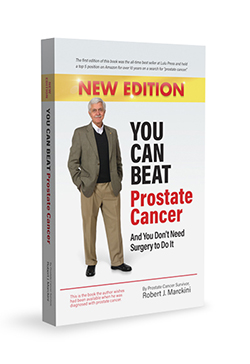 You Can Beat Prostate Cancer: And You Don’t Need Surgery to Do It – Second Edition
You Can Beat Prostate Cancer: And You Don’t Need Surgery to Do It – Second Edition
Bob’s new book still sits in one of the top two positions on an Amazon “prostate cancer” search, and it continues to change lives. We regularly hear from recently diagnosed men or members of their families who tell us how much they learned from the book and how it’s changed their thinking.
A Review of the Book …
Here’s a recent review from a retired endodontist …

I recommend reading Bob Marckini's new edition of You Can Beat Prostate Cancer. As a retired endodontist with a medical background, I found this book to be a comprehensive source of detailed information for anyone wanting to arm himself against the prospects of prostate cancer. From diagnostic testing to treatment options, Bob does a great job presenting specific medical information in an easy-to-understand way. For me, as a 69-year-old recently diagnosed with low-risk prostate cancer, Bob’s book afforded me the ability to ask the right questions of my urologist. With this book I feel I have the information that will allow me to be the best advocate for my own health. Thank you, Bob, for being a true pioneer.
Did you find Bob’s new book helpful?
Please write a review on Amazon.
We’re happy to discount books in quantity (minimum 20) to anyone interested in spreading the word on proton therapy. Just send an email to Deb Hickey. Proceeds from book sales are used to help fund our efforts and to support proton therapy research.
The Kindle version is free to Kindle Unlimited members or can be purchased for $9.99 for non-members. The paperback price is $22.45. Buy You Can Beat Prostate Cancer second edition on Amazon or Lulu Press.

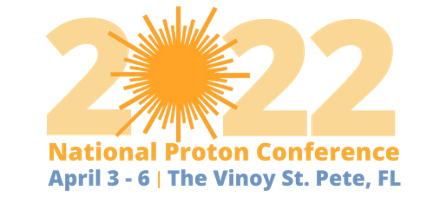 The National Association for Proton Therapy (NAPT) will be holding its next annual conference in St. Petersburg, FL, April 3-6, 2022. There will be two full days of in-person engagement, education, and collaboration among experts in the proton therapy world.
The National Association for Proton Therapy (NAPT) will be holding its next annual conference in St. Petersburg, FL, April 3-6, 2022. There will be two full days of in-person engagement, education, and collaboration among experts in the proton therapy world.
Exhibits: There are typically large halls filled with exhibits showing the latest developments in proton therapy technology, equipment, systems, and support systems. Information is presented on new particle accelerator design, new beam delivery systems, more precise control systems, and many things connected with proton therapy.
Attendance: Proton therapy centers from all over the world send representatives to the conference. Often clinicians and clinical leaders from all the major U.S. proton centers are in attendance, and many participate in panel discussions. Other attendees include physicists, senior administrative officials, and vendors who design and make equipment, products, and systems that support proton therapy and related technologies.
Panels and Presentations: Several presenters and panels will address a variety of proton-related issues ranging from the latest developments in proton therapy research, clinical and technological advances in proton therapy, global proton initiatives, and the economics and sustainability of proton center development and growth.



Last Month’s Brain Teaser
Something extraordinary happened on the 6th of May 1978 at 12:34 a.m. What was it?
Even with the typo in our last newsletter (we’d written 12:24 instead of 12:34), we received all correct responses from our members (we’re not surprised).
Answer: At that moment, the time and day could be written as: 12:34, 5/6/78
Winner: BOB member Richard Williams of Sandpoint, ID, is the brain teaser winner. In an email to Deb, he wrote:
You and your father are truly disciples of God. Keep up the great work.
New Brain Teaser
There is a word in the English language in which the first two letters signify a male, the first three letters signify a female, the first four signify a great man, and the whole word, a great woman. What is the word?
Send your brain teaser answer to [email protected] for a chance to win a signed copy of Bob Marckini’s NEW second edition book, You Can Beat Prostate Cancer.
Church Secretaries With Typewriters
The following sentences appeared in church bulletins or were announced at church services. Thank God for church secretaries with typewriters …
The sermon this morning: “Jesus walks on the water.” The sermon tonight: “Searching for Jesus.”
Ladies – don’t forget the rummage sale! It’s a chance to get rid of those things not worth keeping around the house. Bring your husbands.
Don’t let worry kill you off – let the church help.
For those of you who have children and don’t know it, we have a nursery downstairs.
Next Thursday there will be try-outs for the choir. They need all the help they can get.
At the evening service tonight, the sermon topic will be “What is Hell?” Come early and listen to our choir practice.
Eight new choir robes are needed due to the addition of several new members and to the deterioration of some older ones.
Please place your donation in the envelope along with the deceased person you want remembered.
This evening at 7 PM there will be a hymn singing in the park across from the church. Bring a blanket and come prepared to sin.
Low Self Esteem Support Group will meet Thursday at 7 PM. Please use the back door.
Weight Watchers will meet at 7 PM at the First Presbyterian Church. Please use large double door at the side entrance.
And finally …
The eighth graders will be presenting Shakespeare’s Hamlet in the church basement Friday at 7 PM. The congregation is invited to attend this tragedy.



Estate Planning Hints
BOB Member Ron Hendricks is Director, US Foundation for Trinity Western University. He regularly copies us on his “News from Ron” mailings, which are helpful hints on estate planning to the readers of his newsletters. We have found Ron’s suggestions to be timely and beneficial. With his permission we periodically share some of his wisdom with our membership. This segment is called . . .
Who Gets the Stuff?
 When you are planning your legacy, there are several decisions that must be made. You need to decide who gets the stuff (Executor or Trustee), who gets the kids (Guardianship) and where everything is going (Beneficiaries). You may select one of several options whether you are a single person or a married couple.
When you are planning your legacy, there are several decisions that must be made. You need to decide who gets the stuff (Executor or Trustee), who gets the kids (Guardianship) and where everything is going (Beneficiaries). You may select one of several options whether you are a single person or a married couple.
After selecting your desired planning option, you will be able to enter the information for that plan. If you do not make these decisions, please remember the state already has a plan for you and you will not like what they have planned for you.
1. Simple Will. With a simple will, you may transfer specific property, then give away what is left (the “residue” of your estate). Your simple will may transfer your property to family members or favorite charities.
2. Will with Trust for Minor Children. If you are a single parent with minor children, it will be important to select a guardian and a trustee to manage assets for their benefit. This is not something that you want the state to decide for you.
3. Will with “Give It Twice” Trust. A “Give It Twice” Trust pays income to yourself during your lifetime or your family after your death with the remainder to charity. It can be funded during your lifetime with appreciated assets or at your death with your retirement funds avoiding all capital gain taxes on your retirement account. This is a wonderful way to provide an income to yourself for your lifetime; then to your children for a number of years; and still give to the charity of your choice.
4. Retirement plans to charities (bypassing all taxes due) and the balance of your estate to children (generally tax free). Retirement plans transfer by beneficiary designation outside the will. Do you have your plan up to date and in proper order?
Quote of the Month:
“The really happy person is one who can enjoy the scenery on a detour.” – Anonymous



The Best of Times – Born Between 1930 & 1946 (Source)
You are the smallest group of children, born since the early 1900s. You are the last generation, climbing out of the depression, who can remember the winds of war and the impact of a world at war which rattled the structure of our daily lives for years. You are the last to remember ration books for everything from gas to sugar to shoes to stoves. You saved tin foil and poured fat into tin cans. You saw cars up on blocks because tires weren't available.
You can remember milk being delivered to your house early in the morning and placed in the “milk box” on the porch. You are the last to see the gold stars in the front windows of grieving neighbors whose sons died in the war. You saw the “boys” home from the war, build their little houses. You are the last generation who spent childhood without television; instead, you imagined what you heard on the radio.
With no TV until the ’50s, you spent your childhood playing outside. Andn the lack of television in your early years meant that you had little real understanding of what the world was like. On Saturday afternoons, the movies gave you newsreels sandwiched in between westerns and cartoons. Telephones were one to a house, often shared (party lines) and hung on the wall in the kitchen or on a table in the foyer (no cares about privacy).
Computers were called calculators; they were hand cranked. Typewriters were driven by pounding fingers, throwing the carriage, and changing the ribbon. “Internet” and “Google” were words that did not exist. Newspapers and magazines were written for adults and the news was broadcast on your radio in the evening. As you grew up, the country was exploding with growth.
The government gave returning veterans the means to get an education and spurred colleges to grow. Loans fanned a housing boom. Pent-up demand coupled with new installment payment plans opened many factories for work. New highways would bring jobs and mobility. The veterans joined civic clubs and became active in politics.
The radio network expanded from three stations to thousands. Your parents were suddenly free from the confines of the depression and the war, and they threw themselves into exploring opportunities they’d never imagined. You weren’t neglected, but you weren’t today’s all-consuming family focus. They were glad you played by yourselves until the streetlights came on.
They were busy discovering the post-war world. You entered a world of overflowing plenty and opportunity; a world where you were welcomed, enjoyed yourselves and felt secure in your future, though depression and poverty were deeply remembered. Polio was still a crippler.
You came of age in the 50s and 60s. You are the last generation to experience an interlude when there were no threats to our homeland. The second world war was over, and the cold war, terrorism, global warming, and perpetual economic insecurity had yet to haunt life with unease.
Only your generation can remember both a time of great war, and a time when our world was secure and full of bright promise and plenty. You grew up at the best possible time, a time when the world was getting better.
You are “The Last Ones.” More than 99 percent of you are either retired or deceased, and you feel privileged to have “lived in the best of times!”
Low PSAs to all,
Bob Marckini and Deb Hickey
To print the BOB Tales newsletter or view the newsletter with a larger font size, click here for the PDF file.
NO MEDICAL ADVICE: Material appearing here represents opinions offered by non-medically-trained laypersons. Comments shown here should NEVER be interpreted as specific medical advice and must be used only as background information when consulting with a qualified medical professional.
